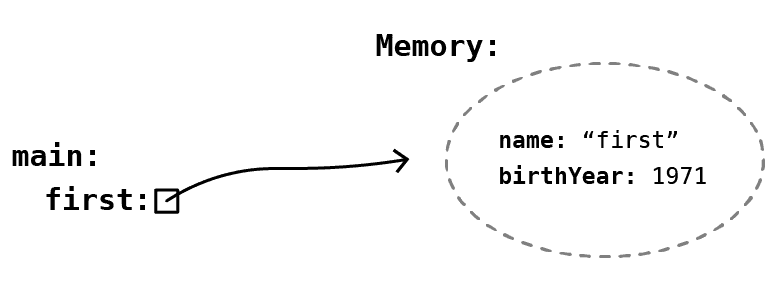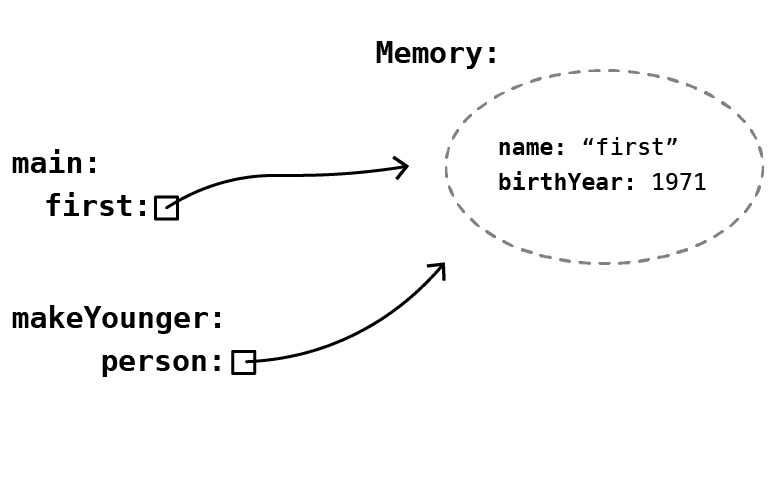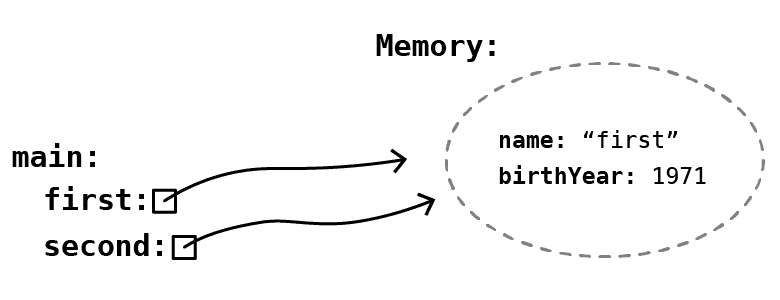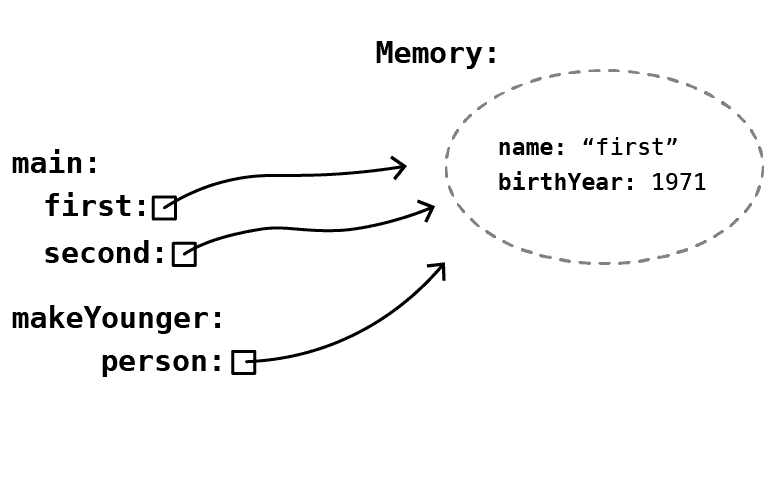Primitive and reference variables
Variables in Java are classified into primitive and reference variables. From the programmer's perspective, a primitive variable's information is stored as the value of that variable, whereas a reference variable holds a reference to information related to that variable. reference variables are practically always objects in Java. Let's take a look at both of these types with the help of two examples.
int value = 10;
System.out.println(value);10
public class Name {
private String name;
public Name(String name) {
this.name = name;
}
}Name luke = new Name("Luke");
System.out.println(luke);Name@4aa298b7
In the first example, we create a primitive int variable, and the number 10 is stored as its value. When we pass the variable to the System.out.println method, the number 10 is printed. In the second example, we create a reference variable called luke. A reference to an object is returned by the constructor of the Name class when we call it, and this reference is stored as the value of the variable. When we print the variable, we get Name@4aa298b7 as output. What is causing this?
The method call System.out.println prints the value of the variable. The value of a primitive variable is concrete, whereas the value of a reference variable is a reference. When we attempt to print the value of a reference variable, the output contains the type of the variable and an identifier created for it by Java: the string Name@4aa298b7 tells us that the given variable is of type Name and its identifier is 4aa298b7.
The previous example applies whenever the programmer has not altered an object's default print format. You can modify the default print by defining the toString method within the class of the given object, where you specify what the objects print should look like. In the example below, we've defined the public String toString() method within the Name class, which returns the instance variable name. Now, when we print any object that is an instance of the Name class with the System.out.println command, the string returned by the toString method is what gets printed.
public class Name {
private String name;
public Name(String name) {
this.name = name;
}
public String toString() {
return this.name;
}
}Name luke = new Name("Luke");
System.out.println(luke); // equal to System.out.println(luke.toString());Luke
Primitive Variables
boolean (a truth value: either true or false), byte (a byte containing 8 bits, between the values -128 and 127), char (a 16-bit value representing a single character), short (a 16-bit value that represents a small integer, between the values -32768 and 32767), int (a 32-bit value that represents a medium-sized integer, between the values -231 and 231-1), long (a 64-bit value that represents a large integer, between values -263 and 263-1), float (a floating-point number that uses 32 bits), and double (a floating-point number that uses 64 bits).Out of all of these, we've mainly been using the truth value (boolean), integer (int) and floating-point variables (double).
boolean truthValue = false;
int integer = 42;
double floatingPointNumber = 4.2;
System.out.println(truthValue);
System.out.println(integer);
System.out.println(floatingPointNumber);false 42 4.2
Declaring a primitive variable causes the computer to reserve some memory where the value assigned to the variable can be stored. The size of the storage container reserved depends on type of the primitive. In the example below, we create three variables. Each one has its own memory location to which the value that is assigned is copied.
int first = 10;
int second = first;
int third = second;
System.out.println(first + " " + second + " " + third);
second = 5;
System.out.println(first + " " + second + " " + third);10 10 10
10 5 10The name of the variable tells the memory location where its value is stored. When you assign a value to a primitive variable with an equality sign, the value on the right side is copied to the memory location indicated by the name of the variable. For example, the statement int first = 10 reserves a location called first for the variable, and then copies the value 10 into it.
Similarly, the statement int second = first; reserves in memory a location called second for the variable being created and then copies into it the value stored in the location of variable first.
The values of variables are also copied whenever they're used in method calls. What this means in practice is that the value of a variable that's passed as a parameter during a method call is not mutated in the calling method by the method called. In the example below, we declare a 'number' variable in the main method whose value is copied as the method call's parameter. In the method being called, the value that comes through the parameter is printed, its value is then incremented by one. The value of the variable is then printed once more, and the program execution finally returns to the main method. The value of the 'number' variable in the main method remains unaltered because it has nothing to do with the 'number' variable defined as the parameter of the method that's called.
Reference Variables
All of the variables provided by Java (other than the eight primitive variables mentioned above) are reference type. A programmer is also free to create their own variable types by defining new classes. In practice, any object instanced from a class is a reference variable.
Let's look at the example from the beginning of the chapter where we created a variable called 'leevi' of type Name.
Name leevi = new Name("Leevi");The call has the following parts:
- Whenever a new variable is declared, its type must be stated first. We declare a variable of type
Namebelow. For the program to execute successfully, there must be aNameclass available for the program to use.
Name ...- We state the name of the variable as its declared. You can reference the value of the variable later on by its name. Below, the variable name is defined as leevi.
Name leevi...- Values can be assigned to variables. Objects are created from classes by calling the class constructor. This constructor defines the values assigned to the instance variables of the object being created. We're assuming in the example below that the class
Namehas a constructor that takes a string as parameter.
... new Name("Leevi");- The constructor call returns a value that is a reference to the newly-created object. The equality sign tells the program that the value of the right-hand side expression is to be copied as the value of the variable on the left-hand side. The reference to the newly-created object, returned by the constructor call, is copied as the value of the variable
leevi.
Name leevi = new Name("Leevi");The most significant difference between primitive and reference variables is that primitives (usually numbers) are immutable. The internal state of reference variables, on the other hand, can typically be mutated. This has to do with the fact that the value of a primitive variable is stored directly in the variable, whereas the value of a reference variable is a reference to the variable's data, i.e., its internal state.
Arithmetic operations, such as addition, subtraction, and multiplication can be used with primitive variables — these operations do not change the original values of the variables. Arithmetic operations create new values that can be stored in variables as needed. Conversely, the values of reference variables cannot be changed by these arithmetic expressions.
The value of a reference variable — i.e., the reference — points to a location that contains information relating to the given variable. Let's assume that we have a Person class available to us, containing an instance variable 'age'. If we've instantiated a person object from the class, we can get our hands on the age variable by following the object's reference. The value of this age variable can then be changed as needed.
Primitive and Reference Variable as Method Parameters
We mentioned earlier that the value of a primitive variable is directly stored in the variable, whereas the value of a reference variable holds a reference to an object. We also mentioned that assigning a value with the equality sign copies the value (possibly of some variable) on the right-hand side and stores it as the value of the left-hand side variable.
A similar kind of copying occurs during a method call. Regardless of whether the variable is primitive or reference type, the value passed to the method as an argument is copied for the called method to use. With primitive variables, the value of the variable is conveyed to the method. With reference variables, it's a reference.
Let's look at this in practice and assume that we have the following Person class available to us.
public class Person {
private String name;
private int birthYear;
public Person(String name) {
this.name = name;
this.birthYear = 1970;
}
public int getBirthYear() {
return this.birthYear;
}
public void setBirthYear(int birthYear) {
this.birthYear = birthYear;
}
public String toString() {
return this.name + " (" + this.birthYear + ")";
}
}We'll inspect the execution of the program step by step.
public class Example {
public static void main(String[] args) {
Person first = new Person("First");
System.out.println(first);
youthen(first);
System.out.println(first);
Person second = first;
youthen(second);
System.out.println(first);
}
public static void youthen(Person person) {
person.setBirthYear(person.getBirthYear() + 1);
}
}First (1970) First (1971) First (1972)
The program's execution starts off from the first line of the main method. A variable of type Person is declared on its first line, and the value returned by the Person class constructor is copied as its value. The constructor creates an object whose birth year is set to 1970 and whose name is set to the value received as a parameter. The constructor returns a reference. Once the row has been executed, the program's state is the following — a Person object has been created in memory and the first variable defined in the main method contains a reference to it.
*In the illustrations below, the call stack is on the left-hand side, and the memory of the program on the right.

On the third row of the main method, we print the value of the variable first. The method call System.out.println searches for the toString method on the reference variable that has been given to it as the parameter. The Person class has the toString method, so this method is called on the object referenced by the first variable. The value of the name variable in that object is "First", and the value of the birthYear variable is 1970. The output becomes "First (1970)".
On the fourth row, the program calls the youthen method, to which we pass the variable first as an argument. When the method youthen is called, the value of the parameter variable is copied to be used by the youthen method. The execution of the main method remains waiting in the call stack. As the variable first is a reference type, the reference that was created earlier is copied for the method's use. At the end of the method execution, the situation is as follows — the method increments the birth year of the object it receives as a parameter by one.

When the execution of the method makeYounger ends, we return back to the main method. The information related to the execution of the makeYounger disappears from the call stack.

Once we've returned from the method call, we once again print the value of the variable first. The object referenced by the variable first has been mutated during the youthen method call: the birthYear variable of the object has been incremented by one. The final value printed is "First (1971)".
A new Person-type variable called second is then declared in the program. The value of the variable first is copied to the variable second, i.e., the value of the variable second becomes a reference to the already-existing Person object.

The program calls the youthen method after this, which is given the second variable as a parameter. The value of the variable passed during the method call is copied as a value for the method, i.e., the method receives the reference contained in the second variable for its use. After the method's execution, the birth year of the object referenced by the method has increased by one.

Finally, the method execution ends, and the program returns to the main method where the value of the variable first is printed one more time. The final result of the print is "First(1972)".
Log in to view the quiz
Log in to view the quiz
Remember to check your points from the ball on the bottom-right corner of the material!